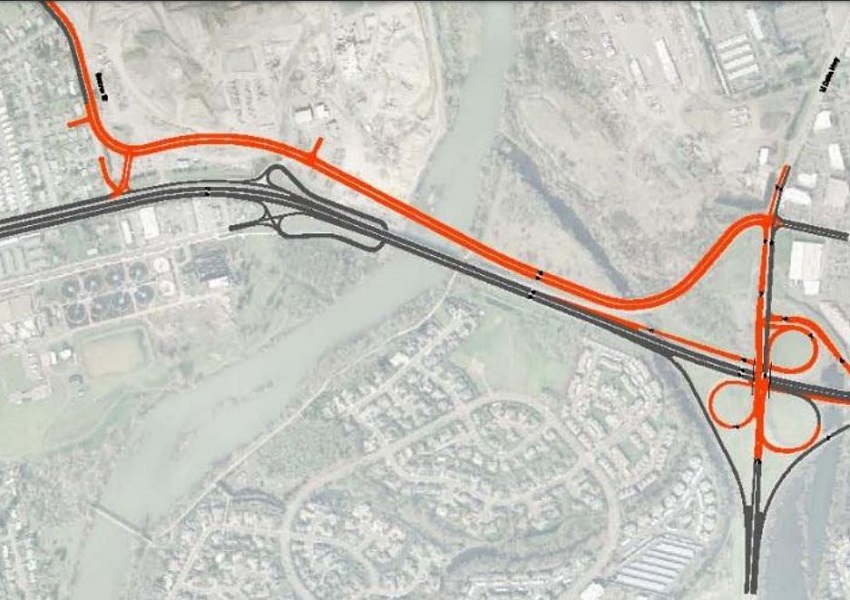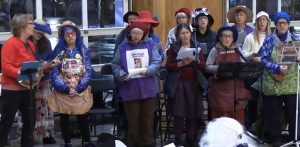RRCO panelists share their thoughts on adding lanes to the Beltline
7 min read
A local arterial bridge connecting Green Acres Road to the Beaver - Hunsaker area could reduce Beltline traffic by 25 percent.
The River Road Community organized a panel discussion about adding more traffic lanes to the Beltline. From the Oregon Department of Transportation, Frannie Brindle.
[00:00:09] Frannie Brindle: The problem with the Beltline Highway is, it’s a 1950s facility. It was not really constructed for today’s traffic volume and load. The interchanges are considered too close together. It’s one of the most congested places in the Eugene -Springfield area, and it’s really the only way to cross the Willamette River in north Eugene. It’s got outdated short entrance ramps and limited space for merging, which contributes to congestion and safety issues, particularly between River Avenue and Division Avenue and Delta Highway.
[00:00:45] A facility plan recommended several projects: to widen the Beltline Highway to three lanes in each direction from River Road to Delta Highway to improve safety and mobility; replace the existing bridges over the Willamette River for both resilience and for congestion, and add a new local bridge to address multimodal and local connectivity issues.
[00:01:08] The local arterial bridge, the one that is from Goodpasture Island Road to Division, is supposed to take about 25 percent of the traffic off of the Beltline. The local arterial bridge serves to take basically the traffic that are local trips to and from shopping to the community. It also will serve to take bike and ped traffic and transit. LTD would have an ability to have an east-west route.
[00:01:41] John Q: From the Public Works Department, Rob Inerfeld highlighted many City of Eugene initiatives, and explained why a new bridge is needed.
[00:01:49] Rob Inerfeld: The current Beltline bridge over the river is not seismically retrofitted. It’s not seismically sound. So if we have a subduction zone earthquake, it’s possible that that bridge will fail. And then there would not be a way to get across the river in this part of Eugene.
[00:02:03] John Q: Rob said LCOG may revisit an earlier analysis of greenhouse gas impacts.
[00:02:08] Rob Inerfeld: I also want to let people know this ODOT consultant performed a greenhouse gas analysis a few years ago. However, it did not look at a concept called induced demand, which is, Would there be more driving if there’s more travel lanes? And so I’m working with the Lane Council Of Governments on potentially updating that study to look at induced demand and see what that would mean in terms of greenhouse gas impacts.
[00:02:31] Rob Zako: I am Rob Zako and I’m Executive Director of Better Eugene Springfield Transportation. I just want to provide some context.
[00:02:37] Building a big project like this takes a lot of money, a lot of planning, a lot of time, sometimes decades. $100 million dollars or so for the local bridge, another $700 million or so for Beltline. Typically a project like this needs to have a variety of federal and state sources and a lot of political push behind it.
[00:02:59] For comparison, the I-5/Beltline interchange was conceived of back in the 1990s. It was included in TransPlan. That’s now been constructed or substantially constructed, but it’s taken a generation to do so. It’s ended up costing over $200 million and Congressman DeFazio, Eugene, Springfield, Lane County have all put their weight behind this and state legislatures to cobble together the funding for this.
[00:03:26] There would have to be a similar political push where local leaders in not just Eugene, but in the county would just have to decide that this is probably the most important thing for our generation that needs to be built. And that other projects are going to be set aside until we have funding for this.
[00:03:43] Patrick Kerr: This is Patrick Kerr up here in the Santa Clara Community Organization. For me in the areas, I’ve watched it grow over the years, what our team has talked about is that continuity and connectivity for all modes of transportation.
[00:03:57] I think having a local bridge between Green Acres and the Beaver/Hunsaker area is vitally important to connect our communities. We look at LTD and the different things that we’ve done over the years, built this new station in the Santa Clara area, and we just heard that oh, I guess the nod is to go up River Road with an EmX project.
[00:04:17] I would argue if you put it over to the Green Acres area, we’d have more connectivity and there’d be a lot more utilization and getting people actually out of their cars, and where they need to go versus going downtown and then back up to someplace.
[00:04:31] Santa Clara is a destination area, a bedroom community, people working and playing in the area, we’re going to get people back and forth and having the bridges over the Willamette River that’s the biggest choke point we have, especially in this area and in the city in general. And I think having those connectivity to this community in the right way, is going to be a valuable asset as we go forward, just like the Ruby Street Bridge is going to be a valuable asset to move forward.
[00:04:58] John Q: Kevin Reed from Northeast Neighbors.
[00:05:00] Kevin Reed: My neighbors are very concerned about the amount of congestion with 6,000 new residents coming into our area in just the last two years, with several thousand slated for the next couple of years. The traffic has just gotten to the point where it’s at a standstill. I mean, they’re using Green Acres as an on-ramp to the Beltline. With WinCo going in, that’s going to double that traffic volume.
[00:05:23] So taking some of the pressure off of the Delta and the Beltline is going to really help the River Road area. I think it’s going to be hugely beneficial, especially with the plans for the development of the river park system all the way past Delta, past River Ridge Golf Course. If you were looking at this thing in long range, long-term, it’s exactly what is needed.
[00:05:44] People got to be able to get to their jobs. People got to be able to get their children to school. They’ve got to be able to get them to and from their extracurricular activities, and having a better and easier way to do that, this offers that solution.
[00:05:56] John Q: Speaking against adding more lanes, Jan Spencer.
[00:05:59] Jan Spencer: The state and the city have land use and transportation planning goals. Neighborhoods have a draft neighborhood plan. Here are a few quotes taken from those documents:
- ‘Maximize the conservation of all forms of energy based on sound economic principles.’
- ‘Our transportation system is environmentally responsible.’
- ‘Prepare health and social systems for a different future.’
- ‘A transportation system that is future oriented, environmentally responsible, and transitions to zero carbon.’
[00:06:30] Widening Beltline would categorically betray all those and many other timely state and local planning goals. Widening Beltline would facilitate more cars, more deaths, and more damage to people and planet. Car-centric transportation discriminates against those with limited income, the elderly, the young, and those who simply don’t want to drive, such as myself. Widening Beltline would not conserve energy. Widening Beltline would not help prepare our health and social systems for a different future. The hundreds of millions spent on widening Beltline could deprive funding for transportation and land use planning appropriate for a different future for health social conditions already coming into focus.
[00:07:16] The controversy over Beltline provides us with an opportunity to reset our car-centric way of life towards the vision articulated in those sensible state, city, and neighborhood planning goals. There’s no need for a new breakthrough in technology. The big breakthrough we need is in our own thinking for moving towards a more healthy and green future.
[00:07:41] Mark Robinowitz: We’re talking here about a third of a billion dollars and probably more when all the costs are considered. We don’t have enough money for this and the oil is running out and it takes a lot of fossil fuels to make concrete and steel.
[00:07:54] The oil that we use here in Oregon mostly comes from the Alaska pipeline, which peaked at over two million barrels a day in 1988 and is now under half a million barrels a day. And when it declines a little further, it won’t be able to flow at all because there’s a minimum flow that’s required to go to the pipeline in the winter. Some people think electric cars will solve the problem, but electricity has also peaked.
[00:08:21] So we have to learn to live within our limits, consider low-build options that cost tens of millions instead of hundreds of millions and act like there’s a future that won’t keep growing forever on a finite planet.
[00:08:35] John Q: The panel took a question from Michele Renee.
[00:08:38] Michele Renee: Is it possible that maybe just the footbridge gets built, or the other auxiliary bridge, but not widening Beltline? Are there options other than going for the biggest possible footprint?
[00:08:52] Rob Inerfeld: Our elected leaders could choose to just build a local arterial bridge. My understanding is there needs to be some additional work done at the Delta-Beltline interchange, which is around $20 million because that needs to tie in with the new local arterial bridge that connects Green Acres to Division. But my understanding is those projects could be built and the rest of the Beltline project does not have to be constructed in order to get benefit from those first two phases.
[00:09:18] John Q: River Road convenes a range of views on adding lanes to the Beltline.





